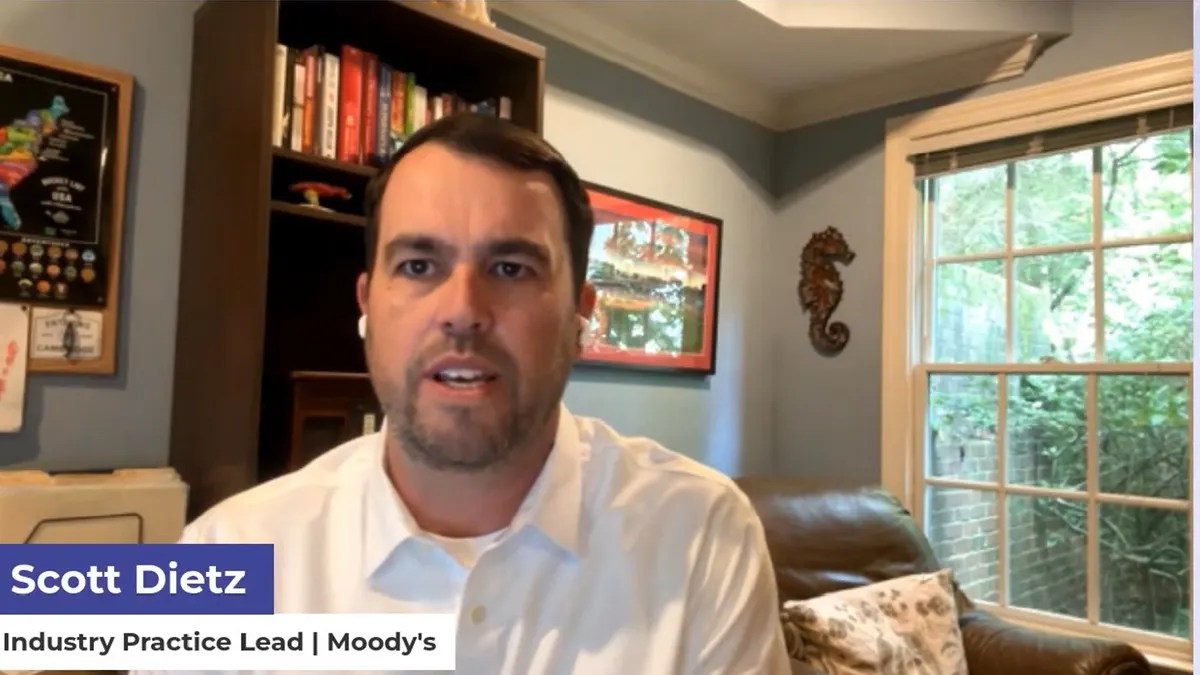Dive Brief:
- U.S. services and manufacturing show glimmers of strength this month, reinforcing forecasts that the economy is gaining momentum after sputtering during the first half of the year, S&P Global said Thursday.
- Business activity grew in August at the fastest pace in 2025 as confidence in the outlook improved, S&P Global said in a report on its Flash Composite PMI. Still, business sentiment remained below the level at the start of the year because of concerns about tariffs and other shifts in government policy.
- The purchasing managers survey “adds to signs that U.S. businesses have enjoyed a strong third quarter so far,” Chris Williamson, chief business economist at S&P Global Market Intelligence, said in a statement. “The data are consistent with the economy expanding at a 2.5% annualized rate” compared with a 1.3% gain during the first half of 2025, he said.
Dive Insight:
Gross domestic product will likely quicken during the third quarter and expand at a 2.3% annualized rate, according to a Tuesday forecast by the Federal Reserve Bank of Atlanta.
Economic growth is accelerating amid signs of weak hiring and the likelihood that companies in coming weeks will pass on the cost of import duties to consumers.
Indeed, signs of persistent inflation and a softening labor market have thrust Federal Reserve policymakers into a dilemma as they try to fulfill their congressional mandate to ensure both price stability and full employment.
Before their next scheduled meeting on Sept. 16-17, policymakers need to decide whether to hold interest rates steady and risk dimming the outlook for jobs, or trim rates and potentially push up inflation further above their 2% long-term target.
“The credibility of our anchoring that inflation number to 2% is a very important piece of the dual mandate,” Kansas City Fed President Jeffrey Schmid said in a CNBC interview aired Thursday. “We’ve got to be careful about what lowering short term rates would do to the inflation mentality” among businesses and consumers, he said.
“Almost all” Fed officials backed a July 30 decision to hold the federal funds rate at a range between 4.25% and 4.5%, according to minutes of their monetary policy meeting released Wednesday.
Fed Governors Michelle Bowman and Christopher Waller flagged signs of weakness in the job market and dissented from the decision. They both called for a quarter-point cut to the benchmark rate in the first dissent by two central bank governors since 1993.
The S&P survey indicates price pressures may rise.
“Companies across both manufacturing and services are reporting stronger demand conditions, but are struggling to meet sales growth, causing backlogs of work to rise at a pace not seen since the pandemic-related capacity constraints recorded in early 2022,” Williamson said.
Robust demand “has also bolstered firms’ pricing power,” he said. “Companies have consequently passed tariff-related cost increases through to customers in increasing numbers, indicating that inflation pressures are now at their highest for three years.”
Indeed, the producer price index last month rose at the fastest rate in three years, the Bureau of Labor Statistics said last week, as costs from the highest tariffs since the 1930s started to trickle through the supply chain.
The PPI, which measures prices charged by wholesalers, increased a higher-than-forecast 0.9% in July and 3.3% on an annual basis, the BLS reported.
Rising prices for goods and services suggest that consumer prices in coming months will rise further above the Fed’s 2% long-term goal, Williamson said.
Indeed, “the rise in prices signaled by the survey puts the PMI data more into rate hiking rather than cutting territory according to the historical relationship between these economic indicators and” subsequent changes to monetary policy, Williamson said.
Yet most traders in interest rate futures believe the Fed will shrug off signs of rising price pressures and ease monetary policy at its meeting next month. They set 73.5% odds of a quarter-point cut at the two-day gathering ending Sept. 17, according to the CME FedWatch Tool.











